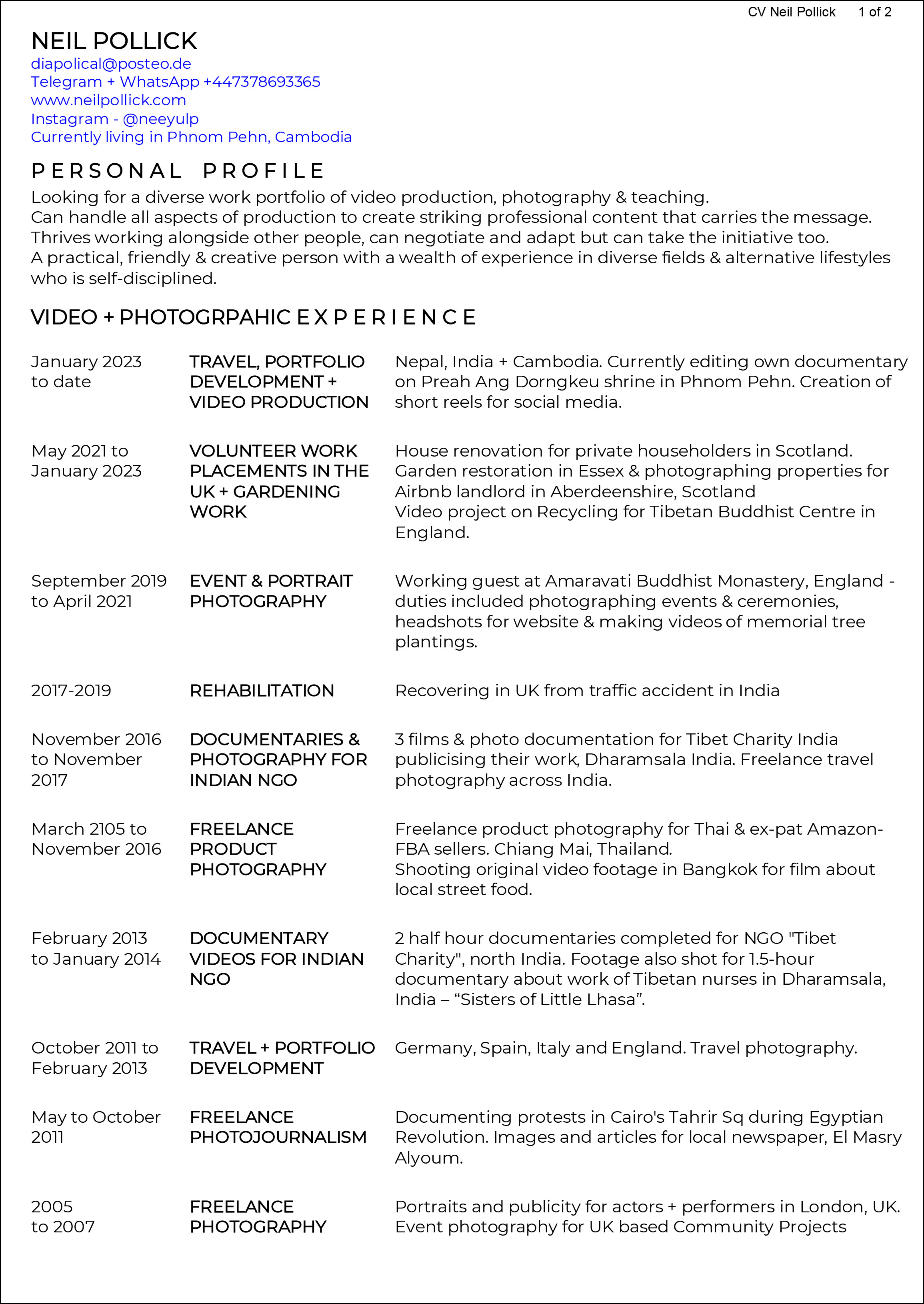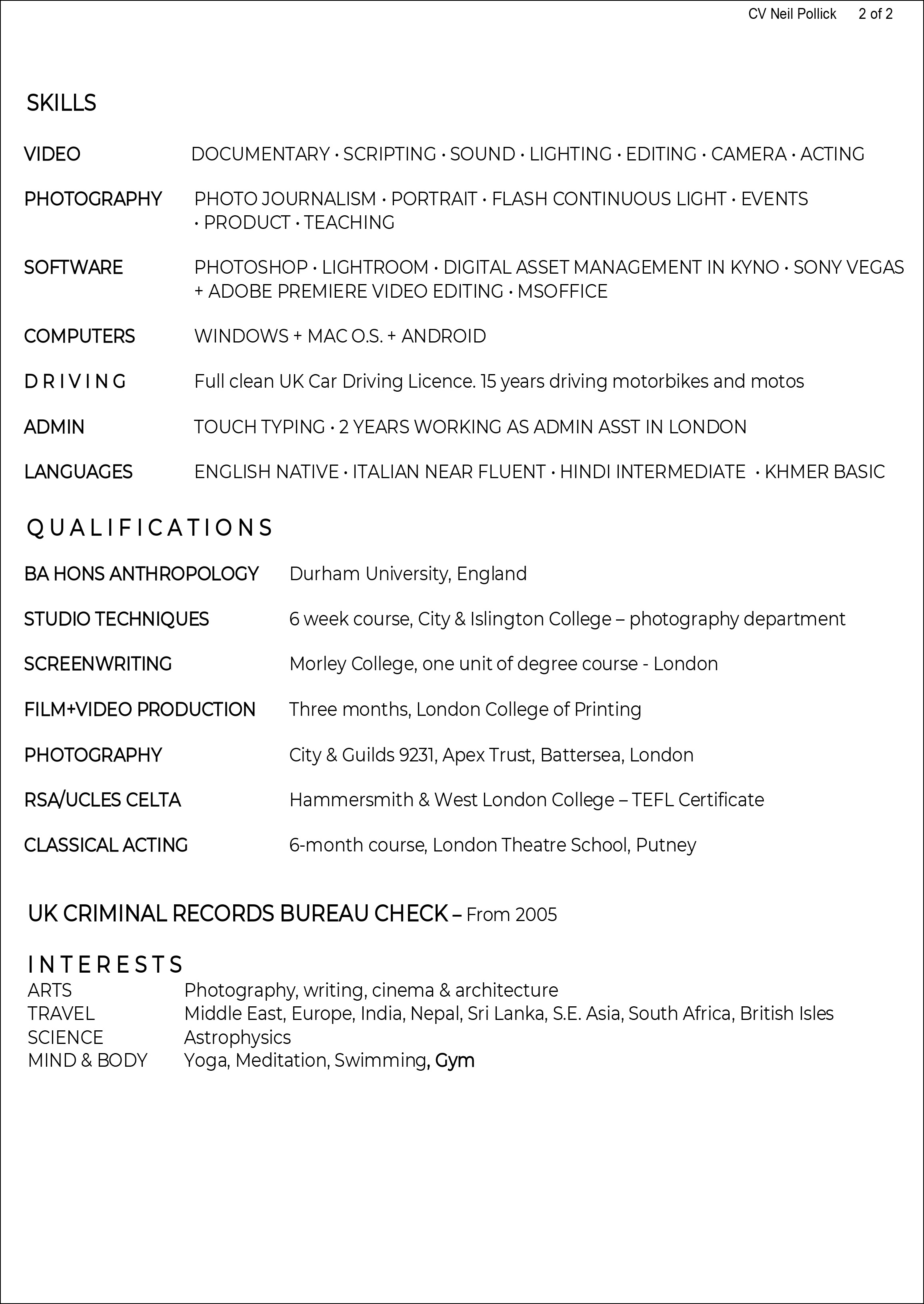EQUIPMENT
Nikon Z6 mirrorless - 26MP stills and 4k video
Sony RX100 V - 20MP stills and 4k video
Professional Shotgun & Lavalier mics
4k video editing Laptop
SOFTWARE
Adobe Photoshop & Lightroom for photography
Vegas Pro, Adobe Premier and Da Vinci Resolve for Video editing
Windows 11


PERSONAL STORY IN FULL
EARLY EFFORTS IN PHOTOGRAPHY
I started off as a photographer in the 80s. I was pursuing a career in acting but an actor needs to be hired before he can act and I wasn't in demand. A photographer doesn't need anybody's assent, he just needs the right equipment and light!
Back then photographs laboured in darkrooms lit only by dim red
bulbs, the only kind that didn't contaminate the paper. A single image was projected
from a negative onto photo sensitive paper before it was treated in a
chemical bath to make the photo appear. The fragile image was stabilized
in fixing solution so that it wouldn't fade away under the light of
day.
I came out of my bathroom-darkroom smelling like an
embalmer, nobody wants an undertaker for a friend. Sometimes every
surface in my living room was covered in curling monochrome photographs
which I cycled across my walls as the work progressed.
TRAINING
I had just 10 months of formal training in
that time on a City & Guilds course in London, I taught myself
mostly on B&W film and cheap out of date slide film that I scooped
out of a huge dwindling barrel at a pharmacy In London Bridge every
Friday night after my 9-5 broke for the weekend. It went off to Kodak
every Monday morning and was back in time for vision and techniques to
be refined for the next weekend's round.
I had no access to a
studio at at that time and that was very frustrating since I really did
want to do more portraiture in controlled lighting. It was much later
that I did a 6 week course in Advanced Studio Techniques at City and
Islington college in London.
EARLY INSPIRATION
I saw a photograph by Amselm Adams advertising an exhibition of his work on the walls of the London Underground. This photograph provoked something in me, and set me on an arc to match that photograph at some level. I am not sure how exactly, perhaps it was just the ambition to reach the same level of technical mastery. I believe I achieved this later on and at that moment the arc was closed. But photography has many angles.
I had also been inspired by an image I had seen in a dream of a photograph of a white wall, presented in the dream as being taken during the First World War. The wall was featureless though not without texture. That seemed to be the point, how to use the photographic art to make an intrinsically uninteresting subject fascinating. I now understand that at a deeper level this is the drive to make the hidden manifest, which is what is behind a lot of photographic endeavour.
To me this is the illusory nature of art and photogrpahy, even images looking literal are not realistic, there just is no objective reality. To photograph , paradoxically, that which cannot be seen means to show things which have left a trace but which are absent from the image, things for which the seen elements are only metaphors, or truths that are not visual (such as social realities) but which photographs can attest to. (the latter is something I finally got to explore in Egypt).
Often the single image cannot convey the meaning, nor tell the story, nor carry the message and the free-standing single image becomes an absurdity, needlessly limited, defined only by convention and often not suitable to the task of communicating. Photographs can be striking, emotive and informative in themselves but the idea that a single image can incapsulate an era, a social movement, let alone a single event or even a personality, is a reductionist fallacy.
TECHNICAL RESTRAINTS
In retrospect I now see that the greater technical/equipment element in photography as compared to
other art forms, also drew me to it. I don't think I was confident in my
creativity and I thought I could hide behind technique.
I wanted to write but I did not think I had the experience or talent to produce anything worth reading and that my failings would be obvious.
It
took years and a lot of experimentation for me to work out how to approach
photography creativley, how to loosen up.
In actual fact I have found the technical demands of photography quite frustrating over the years, I always wished I could just lift the camera to my eye and take the picture without having to worry about focus and exposure and I lamented how many photographs had been unsuccessful because I had not paid enough attention to the technichal side.
LOOKING FOR DIRECTION
I worked my way through 100 years of photographic cliches until I was confident enough to value my own take on the world. I developed a keen sense of the formal elements that go into making a "beautiful" shot, but was never satisfied with that. I remember at that time valuing only the images that I had been moved to take, images that had moved me when I saw them through the viewfinder. But that was about being moved in an aesthetic sense rather than by the humanity I was showing. In those early days I did not photograph people much, it was only later on that I started using photography to document human activity and tell stories, which I believe is my true vocation.
EARLY PROFESSIONAL WORK
My earliest professional work was taking portfolio and publicity shots for actors and performers outdoors and in the studio, then progressing into event photography for charities in London. I did a series of weddings for Nigerian Christians living in London and a football photo story for Roy of the Rovers comic book.
All of that was done part-time. I had health problems that held me back from full involvement.
Things continued in that fashion until I left the UK in 2007 for a decade of travel in Africa, Europe, the Middle East and Asia.
EGYPTIAN REVOLUTION
I believe my work took a leap forward when I was in Egypt documenting the protests in the iconic Tahrir square in the months following the violent days of the Egyptian revolution in 2010.
It was a unique opportunity to take pictures of a popular revolution. It was such a joyous, creative and emotionally charged environment of human aspiration and yearning and it was all out in the open. The atmosphere was generally so friendly that I had no problem taking pictures.
A lot of people wanted me to take their picture because they had a cause to publicise and were holding up a slogan, a placard or a photograph. Others welcomed anyone who wanted to show that world what their revolution was about. The people on the stage didn't hold back and didn't care about who was photographing them. People from every walk of life and social condition came to the square, curious, incredulous, alarmed, inspired and confused and they were so absorbed in what they saw that they never even noticed me there photographing them.
From time to time I came across people, most probably undercover police or state security who told me to stop taking pictures but pointing out
these agents to the revolutionaries in the area always scared them off.
Never was such a display laid before the eyes of an ambitious photographer.
PUBLICISING THE REVOLUTION
Every weekend I went to centre of the ongoing protests, the iconic Tahrir Square. I was entirely sympathetic to the cause of the revolutionaries, I heard their stories, I understood what their lives were like and the oppression they lived under. Their cause became mine.
I naively thought that a new era of democracy and freedom was coming to the country and that I could be part of it. I was looking for a renaissance in my own life and I thought I would find purpose and direction by serving their cause. Not just as a photographer, but in other capacities once a demcoratic state was securely established and open-minded experienced people would be needed as guides and advisors.
But while the protests went on I tried to contribute by documenting them and putting the pictures online to garner support. Most of all I wanted to show how the revolution wasn't the work of foreign-led lawless extremeists but a response to the aspirations of ordinary Egyptian citizens who just wanted to live lives of freedom, prosperity and dignity.
I was freed up in that environment, the camera got closer to my eye. I
learned how to capture the actual things I saw more
spontaneously. I developed an ability to connect with
people and put them at ease quickly. I became decisive in
capturing significant moments and fleeting displays of character.
What I
learned in Egypt informed and enriched my work for NGOs and my travel
photogrpahy in India, Europe Asia in the following years.
MOVING INTO FILM
A theme of story telling had gradually manifest in my photography and that same imperative caused me to become frustrated with the single image. If one photo could tell a story, how much richer a story could a stream of images convery. A single image can only be stretched so far, the natural progression was develpoment through multiple images, through film. Film, the emergent property of streamed photographs.I started making short films on Super 8 film stock in the 1980s, bleak documentations of the life around me, such as a snow storm that swept across my housing estate and an urban detainee following a bird across the sky in dream of freedom. I was trying to find meaning in my urban confinement, I made a silent short about a man who takes shots at random strangers on the estate and chooses not to kill himself at the end after his spree is done because his act is not based in self hatred. I was protesting.
In 1993 I got onto a 6 week Film & Video Production course at the London College of Printing. It covered all aspects of the process of production. We shot on 16mm film adjusting exposure with light meters, later rolling the printed celluloid reels through film editors by hand to watch on tiny bright screens. We cut them on clamp-down splicers and re-attached them with sprocketed tape. This was just how I had dealt with Super 8.
When the course was done I made a more ambitious film on Super 8 with the help of friends from the LCP course. It was an 8 minute narrative called Betrayed based on a dream. I kept the plot simple becasue I didn't want to delay. The idea was that a man dreams he is trapped in his apartment and all his efforts to get out come to nothing. He gets a cryptic message through his letter box making him ponder on the idea of betryal. He wakes in the morning to find himself not trapped at all and he throws open the windows and doors in a symbolic gesture of his willingness to engage with life, realising the one betraying him is he himself. The plot is simple and the film relies on eerie high-key lighting and evocative music to communicate the idea the dreamlike quality. It created some interest but was declined from broadcast by Channel 4 in the UK because of the "low production values".
